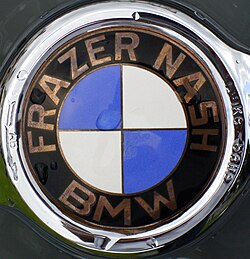
Frazer Nash was a brand of British sports car manufactured from 1922 first by Frazer Nash Limited founded by engineer Archibald Frazer-Nash. On its financial collapse in 1927 a new company, AFN Limited, was incorporated. Control of AFN passed to Harold John Aldington in 1929.
Contents
- History
- Archie Frazer Nash
- Aldington brothers
- Frazer Nash BMW
- Bristol BMW
- Porsche
- Post War Weapons and Multi Market Engineering until now
- Products
- Pre-war models
- Post-war models
- Complete World Championship of Drivers results
- World Sportscar Championship
- See also
- Notes
- References
- Bibliography
- External links
Until the Second World War AFN continued to produce a small number of sports cars badged Frazer Nash incorporating a unique multi-chain transmission. It continued after the war making another 85 sports cars before ending manufacture in 1957. The post-war cars had conventional transmissions.
UK agents for BMW arranged coachwork and made modifications, including badging the cars "Frazer Nash BMW".
Control of AFN Limited, UK agents for Porsche, passed from the Aldington family to Porsche in 1987.















